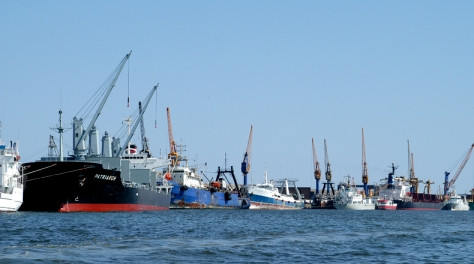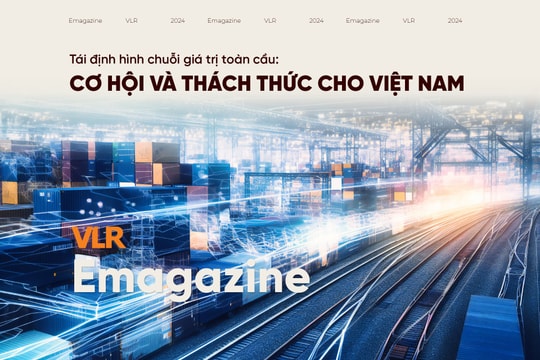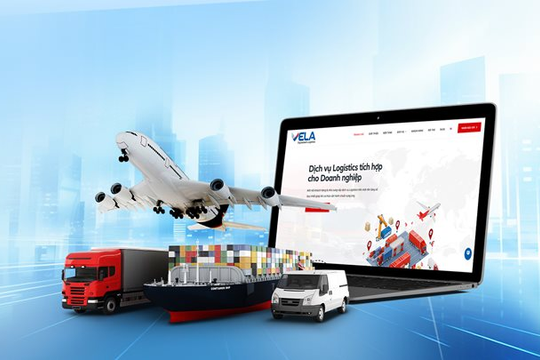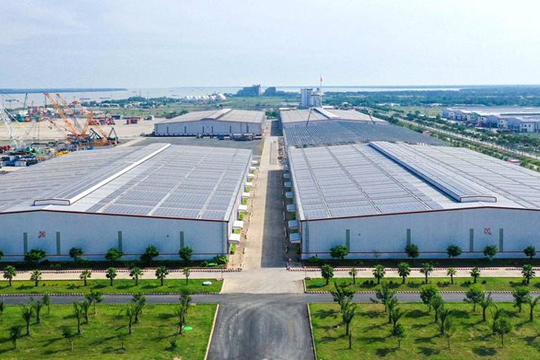
Logistics has become a widely-mentioned topic in the period of innovation and of developing the sea-based economy of Vietnam. At the present, over 1,000 home businesses operating in the logistics sector only account for 20-25% market share, whereas only 1/10 of oversea logistics “deep pockets” operating in Vietnam grabs 80% of the rest. Is it possible for the home business to gain the upper hand in the important sector in 2014, the time when the maritime opens the market in accordance to WTO Commitment?
A BRIEF HISTORY OF GLOBAL LOGISTICS
Logistics came out and developed at the time of the container revolution in the U.S in the 1950s of the previous century. But thanks to impacts from global science and technology, container transport in particular and logistics in general have had a dramatic growth, which account for 90% of the amount of goods trading among countries.
The role and position of large sea port have been heightened up. They are not simply terminal points of a sea transport mode or breakpoints in the process of cargo circulation, but they have become regional or global multi model transport centers, creating new value added activities that boost the development of sea transport: the container volume in the world keeps increasing, in average of 10.7% annually. It reached 541 million TEU in 2008, and it is expected to reach 824 million TEU in 2013.
As the global trend, the container volume keeps increasing, and the development of global trade boosts establishments of deep water ports, hub ports and international transshipment ports. And they will be free trade zones, closely connected to both local and international traffic network, which is to cut logistics cost. This is a significant innovation in operating, managing and cooperating to enhance working capacity of the global sea transport, leading to “green ports, clean environment”- minimizing “green house effect” – being ready to deal with global weather change at the end of the 21st century.
LOGISTICS REALITY IN VIETNAM
Logistics started in Vietnam in the period of open-door policy and the sea cargo started developing. Vietnam logistics is ranked 53/155 countries whose has logistics profit accounting for 10-15% the country’s GDP (around USD8-10 billion/year equally to 12% GDP). However, the concern is that 80% of the market share belongs to international maritime corporations. On the contrary, local logistics businesses are small in scale, operate not so effectively, lack competitive abilities against foreign rivals and thus, take responsibility for parts in the chain (loading/unloading, warehousing, checking, and forwarding…). In fact, they are working for foreign liners. Therefore, international maritime corporations have been controlling the logistics in Vietnam for many years, and the market share has not been changed. The logistics cost in Vietnam may go up to 20% of the transport cost (but only 8-10% in average worldwide).
WHERE TO START TO GAIN THE MARKET SHARE BACK?
Broaden the legal framework
Logistics is a driving force for the development of sea ports and the sea-based economy as well. It is closely related to the maritime in depth and the foreign trade in width. Therefore, logistics cannot be well-operated without these two factors. However, according to some forwarding and foreign trade experts, in The Vietnam Trade Code (last modified February 1st, 2006), logistics is only recognized as a trade practice. And then, the Government issued the Decree 140/2007/NĐ-CP dated September 5th, 2007 that sets conditions of doing logistics business and limits responsibilities of those who do logistics businesses. However, it is so simple, lacking necessary factors that encourage and attract investments or call for a joint-venture to implement a “package” of logistics supply following international practice.
What is more? The concerned authorities have not been paid enough attention to the sector. For example, the Ministry of Transport is responsible for transport management, but in the recent Road Traffic Law, there is no article about logistics mentioned. And the Ministry of Industry and Trade ignores businesses and manufacturers sell CIF and buy FOB, although the practices badly affect logistics competitiveness in international market place. There comes a time when there should be an inter-sector organization that is powerful enough in macro scale to manage all Vietnam’s logistics activities.
The infrastructure and sea ports
Although there have been a lot of improvements, and large investments for the past many years, the traffic infrastructure, weak and in shortage, does not meet requirements of the country’s economy in the time of integration. The railroad system, which has last for over two centuries and has low speed limit, is out dated and is overloaded. National Highway 1A connecting the North and the South is small and narrow, which is often blocked due to yearly floods and storms. The lack of connection between national traffic network and the system of deep water ports, which have been considered as international gateways. The sea ports is nominally many in number (there are 160 nationwide), but have low working effectiveness due to spreading investments, low cargo throughput, the lack of deep water ports and container terminals, not being connected to the traffic network. Only Hai Phong port has a railroad that connects the berth. Generally speaking, Vietnam sea port system is weak in planning, operating management, and equipments compared to those in the region and in the world. The loading/unloading capacity reaches 45-50% for cargo and 40% for container.
For the past few years, ports in joint-venture with foreign businesses in Thi Vai river, Ba Ria-Vung Tau, has come into operation, receiving vessels with capacity of over 120.000DWT and container vessels of 11.000TEU as Tan Cang-Cai Mep, SP-PSA,CMIT and SITV…They are first deep water ports of the country, and they have broken an inconvenient practice- the transshipment at Singapore, Hong Kong, or Kao Sung (Taiwan) on the way to EU or the States. But due to the result of not being well connected to local traffic network, they are sharing the fate with other ports: being in shortage of cargo.
Road 965 and Rach Nga Tu Bridge (Ba Ria-Vung Tau) in ODA project with the capital of USD 1.5 billion, connecting National Highway 51 that serves Cai Mep-Thi Vai ports, that should have been under construction in 2006, but still have not been finished. and thus make the ports isolated.
HUMAN RESOURCES AND ADVANCED EQUIPMENTS
According to statistics, the major of logistics businesses are of private sector with the staff of 10,000 people. But they are weak in both finance and professional, not having enough competitive abilities even on nation scale, to say nothing of the global scale. There have been short-term training courses for logistics staff in the sea ports. But in experts’ judgments, they are not qualified enough to take responsibility for bigger tasks. We do need sponsorship from the Governments, with assistance from universities, to give them knowledge of English, international law, working skills and then equip them with modern technologies to integrate global information network, and electronic gateways of regional sea ports… This is an urgent long-term task, as important as the task of broadening the Vietnam legal framework.
Logistics is the driving force for a faster development and as the same time is the key to open doors to Vietnam sea ports in the period of international integration. How to employ logistics to bring best effectiveness in the period of shifting industry-based economy to knowledge-based economy needs thoughtful consideration from planners of macro-scale. Lessons of success in logistics development from Malaysia and Singapore, together with available data in Vietnam will help determine a proper development logistics strategy for the country.

.jpg)






.jpg)
.jpg)
.jpg)

.jpg)


.jpg)
